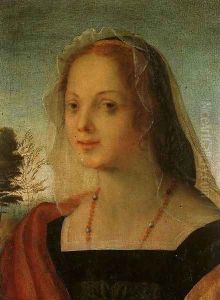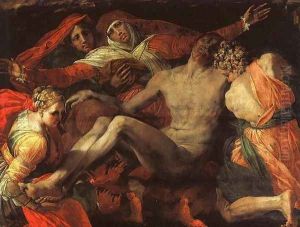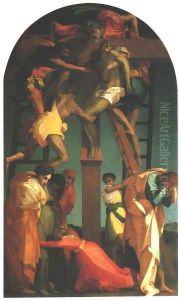Rosso Fiorentino (Giovan Battista di Jacopo) Paintings
Rosso Fiorentino, born Giovan Battista di Jacopo, was an Italian Mannerist painter active primarily in Florence and Rome in the early 16th century. His nickname 'Il Rosso' (meaning 'the Redhead') reflected his bright red hair, a distinctive feature that stood out among his contemporaries. Born in Florence in 1494, Rosso was part of a generation of artists that succeeded the High Renaissance masters like Leonardo da Vinci, Michelangelo, and Raphael.
Rosso's early training was under the guidance of Andrea del Sarto, alongside his contemporary, Jacopo Pontormo. Both artists were significant figures in the development of Mannerism, a style characterized by elongated forms, unusual proportions, and a departure from the balanced compositions and harmony of the Renaissance. Rosso's work is noted for its expressive use of color and dramatic, sometimes unsettling, portrayal of figures and space.
In 1523, Rosso moved to Rome, where he was exposed to the works of Raphael and other High Renaissance artists. However, his stay in Rome was cut short by the Sack of Rome in 1527, after which he fled to northern Italy and eventually to France. Invited by King Francis I, Rosso joined the court at Fontainebleau in 1530, where he became a central figure in the creation of the Fontainebleau School. This group of artists introduced the Italian Mannerist style to France and significantly influenced French art for the next several decades.
At Fontainebleau, Rosso executed some of his most significant works, such as the Gallery of Francis I, which is considered a masterpiece of Mannerist decoration. His work during this period is characterized by sophisticated and elegant figures rendered with a refined use of color and intricate decorative schemes.
Rosso Fiorentino's life was marked by bouts of depression and his eccentric personality, which often alienated him from others. His career was turbulent, with moments of recognition interspersed with periods of financial and personal difficulties. Despite these challenges, his innovative approach and the emotional intensity of his work had a lasting impact on the development of European art. Rosso's unique blend of Florentine training and Roman experience, combined with his time at the French court, made his work a bridge between the Italian and French Renaissance.
Tragically, Rosso's life came to a premature end in 1540. The circumstances of his death are somewhat mysterious, but it is believed he may have committed suicide. His legacy lives on through his influential works and his shaping of the Mannerist aesthetic that dominated European art in the mid-16th century.



















